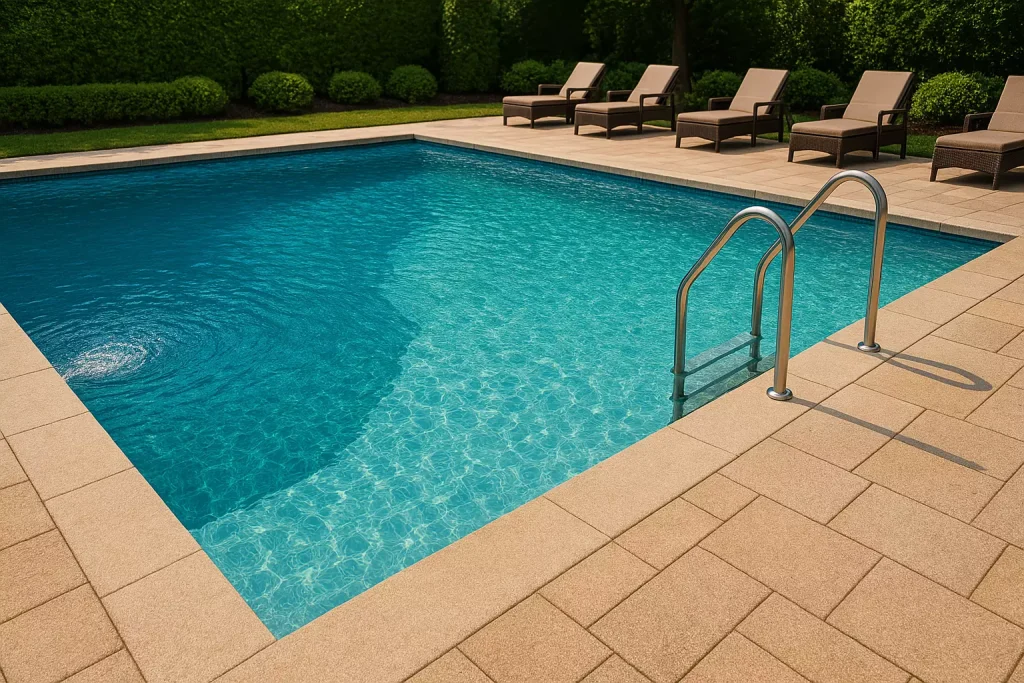
Saltwater, Bromine, vs. Chlorine Pools
Choosing the right sanitation system is one of the most important decisions you’ll make for your inground pool. While chlorine has been the standard for decades, saltwater and bromine systems have gained popularity for their alternative benefits. But how do you decide which one is right for your pool, lifestyle, and maintenance preferences?
In this post, we break down the pros and cons of chlorine, saltwater, and bromine pools to help you understand the differences and make an informed choice.
Chlorine Pools: The Traditional Standard
Chlorine is the most common method of pool sanitation. It works by killing bacteria, algae, and other microorganisms through oxidation. It’s widely available and relatively affordable, making it the go-to for most residential pools.
- Pros: Cost-effective, quick to sanitize, compatible with nearly all pools
- Cons: Can cause skin/eye irritation, strong chemical smell, requires regular manual balancing
Chlorine can be added manually via tablets, liquid, or granules — or automatically via a chlorinator. However, it requires frequent testing and balancing to keep levels safe and effective.
Saltwater Pools: A Softer Alternative
Saltwater pools don’t eliminate chlorine — they generate it. Using a salt chlorine generator, these systems convert salt (sodium chloride) into chlorine through electrolysis. The result is a pool that still uses chlorine to sanitize, but in lower, more consistent doses.
- Pros: Gentler on eyes and skin, lower chlorine odor, less frequent chemical handling
- Cons: Higher upfront cost, salt can corrode metal fixtures, still technically a chlorine pool
Many people report a “silky” feel to the water in saltwater pools, and the system maintains chlorine levels more consistently. However, salt cells need maintenance and replacement over time.
Bromine Pools: The Spa Favorite
Bromine is often used in hot tubs and indoor pools due to its stability at high temperatures and low odor. Like chlorine, it sanitizes by oxidizing contaminants, but it’s less harsh and produces fewer irritants.
- Pros: Works well in warm water, less irritating to skin and eyes, remains active longer after breakdown
- Cons: More expensive, slower to act, sunlight degrades it faster
Bromine is ideal for spas or indoor environments, but it’s also usable in outdoor pools if you don’t mind the higher cost and need for UV protection (like adding stabilizers).
Comparing the Systems
Here’s a quick side-by-side comparison to help you decide:
| System | Cost | Maintenance | Comfort | Best For |
|---|---|---|---|---|
| Chlorine | Low | Moderate (manual) | Can be harsh | Most standard pools |
| Saltwater | Higher upfront | Lower ongoing | Softer on skin | Families, low-maintenance seekers |
| Bromine | High | Moderate | Gentle, low odor | Hot tubs, indoor pools |
Which One Should You Choose?
It depends on your priorities. If you want a tried-and-true solution that’s affordable and easy to find, chlorine is your best bet. If you want a smoother, more automated experience, saltwater systems offer great long-term benefits — especially for outdoor pools.
If you own a spa or heated indoor pool, bromine might give you the most comfortable swim without the strong chlorine scent.
Each system has its trade-offs, so consider how much effort you’re willing to put into maintenance, how sensitive your skin is, and what kind of water experience you want.
Final Thoughts
Whether you go with chlorine, saltwater, or bromine, the key to a clean and healthy pool is consistent care. No system is fully “maintenance-free,” but the right setup can make pool ownership much more enjoyable.
